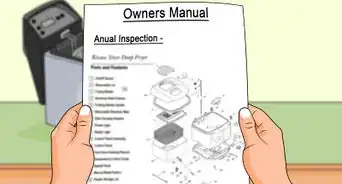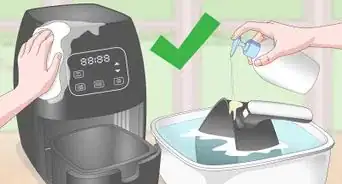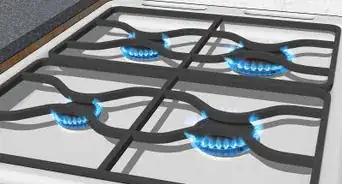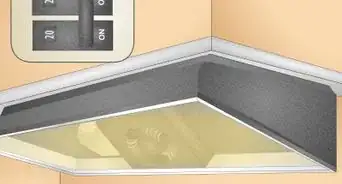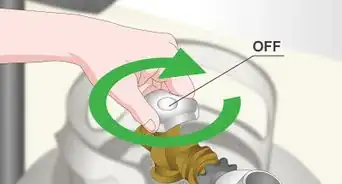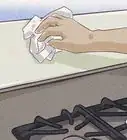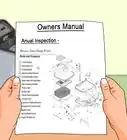This article was co-authored by wikiHow staff writer, Janice Tieperman. Janice is a professional and creative writer who has worked at wikiHow since 2019. With both a B.A. and M.A. in English from East Stroudsburg University, she has a passion for writing a wide variety of content for anyone and everyone. In her free time, you can find her working on a new crochet pattern, listening to true crime podcasts, or tackling a new creative writing project.
This article has been viewed 15,695 times.
Learn more...
A ceramic, or glass cooktop, allows you to cook food on a completely flat surface. This type of cooking area is pretty straightforward to use, and is easy to clean and maintain. If you keep a few important precautions in mind, you’ll be able to keep your appliance in tip-top condition for years to come!
Steps
Selecting the Best Cookware
-
1Choose pots and pans that fit the size of the cooking area. Measure across each of your cooking zones, or burners, to see how wide they are. Keep in mind that ceramic cooktops heat up beneath the surface, and focus heat within these circular areas. Then, measure the bottom of the pots and pans that you use the most. Ideally, aim to use cookware that fits evenly in the cooking zones so the heat can spread consistently.
- For instance, if 1 of your cooking zones is 8 in (20 cm) wide, you’d want to use a pan that’s about 8 in (20 cm) wide.
-
2Pick out stainless steel cookware for your cooktop. Check the labeling on your pots and pans to see what they’re made of. Try to use cookware made with stainless steel, as opposed to stoneware, cast iron, ceramic, or glass. Stainless steel heats up very consistently, which makes it a great candidate for your pots and pans. Other metals, like cast iron, tend to scratch and scuff the ceramic surface.[1]
- If you don’t have stainless steel cookware on hand, heavy-weight aluminum is also a great solution.
Advertisement -
3Opt for cookware that’s more flat than rounded. Flip over your pots and pans and see how curved they are along the bottom. Since ceramic stove tops are completely flat, curved cookware may not heat up as evenly as flatter pots and pans.
- Ideally, the bottom of the pan of pot should be snug against the entire cooking zone.
-
4Select wood or metal cooking tools instead of plastic ones. Pick out utensils that aren’t as likely to melt on a hot cooking surface. If you have a lot of plastic spatulas, it may be worthwhile to invest in a few wooden or metal spoons, which will last longer.[2]
- For instance, use a wooden spoon instead of a plastic spatula when working with a ceramic cooktop.
-
5Clean any food gunk off the bottom of your pans before using them. Wash your dishes thoroughly after they’ve sat on the cooktop for awhile. It can be easy for old crumbs and gunk to build up on the bottom of your cookware, which can leave scuffs and scratches on your cooktop. Before using them, double-check that the bottom of your pots and pans are as smooth as possible, which will save you time in the long run.[3]
Operating the Cooktop
-
1Turn the designated knobs to get your cooktop heated up. Look around your cooktop for specific knobs that control the temperature of your cooking zones. Keep in mind that these knobs may be behind the cooktop, or alongside of it. For specific guidance, consult your user manual for in-depth instructions.[4]
-
2Lift up your pots and pans instead of sliding them along the cooktop. Avoid the temptation to slide your cookware to another cooking zone, even if you’re in a rush. Keep in mind that ceramic can scratch easily, especially if you’re sliding your pots and pans across. Instead, make a conscious effort to lift and lower your dishes when you move them around.[5]
-
3Check the light indicator to see if the cooktop is hot. Keep an eye out for an LED light indicator somewhere on your cooktop. Generally, this light will be illuminated when the cooktop is warm or hot to the touch. Whenever you see this light, do your best not to touch the cooktop, or else you may burn yourself.
- Read through your ceramic cooktop’s user manual for specific instructions and safety precautions.
Cleaning Your Cooktop
-
1Wait for the cooktop to cool down completely before cleaning it. Check your cooktop’s user manual to see how to turn your appliance on and off. Most cooktops have some kind of indicator to let you know when the stovetop is still hot, which can prevent you from burning yourself. If you apply cleaner while the stovetop is still hot, you may do long-term damage to the ceramic surface.[6]
- Hold your hand above the stovetop to see if it feels warm or not.
- Ideally, try to clean off your cooktop whenever it looks messy. For instance, you don’t need to clean off the cooktop if you’re simply boiling a kettle of water.
-
2Brush any obvious crumbs off the stovetop. Grab a sharp scraper and hold it at a 45-degree angle along the edge of your ceramic cooktop. Drag the scraper across the surface of the stovetop, applying a consistent, moderate amount of pressure as you go. At this point, take a clean paper towel or rag and wipe any obvious messes off the stovetop. This will make the cooktop easier to clean, and will help you focus on more stubborn stains.[7]
- Don’t use a dull or damaged scraper for this, or you may end up scratching the cooktop.
-
3Wipe down the cooktop with a specialized cleaner and a paper towel. Spritz the surface of your ceramic cooktop with a cleaning product designed for ceramic surfaces. Rub the cleaner into the stovetop with a rag or paper towel to clean off the entire surface.[8] Don’t apply too much pressure as you clean, or else you may cause the ceramic surface to fracture.[9]
- With cleaners, a little can go a long way! Start with a few drops, and add more cleaner if you need it.
- You can find specialty cleaner online, or at certain stores that sell cleaning supplies.
-
4Spritz over the cooktop with water and wipe it off. Fill an empty spray bottle with water and coat the ceramic surface in a light mist. Take a clean paper towel or rag and go over the cooktop one more time to wipe away any excess cleaner.[10]
- Lukewarm water is fine for this.
Warnings
- Only use cleaners that are specifically designed for ceramic or glass cooktops. Despite the name, traditional glass cleaners aren’t a good cleaning solution for your cooktop, since they tend to have some harsh chemicals in them.[12]⧼thumbs_response⧽
- Avoid using abrasive cleaning pads on your cooktop.[13]⧼thumbs_response⧽
Things You’ll Need
Cleaning Your Cooktop
- Scraper blade
- Paper towel
- Cloth
- Ceramic glass cleaner
- Water
- Spray bottle
References
- ↑ https://products.geappliances.com/appliance/gea-support-search-content?contentId=16259
- ↑ https://www.consumerreports.org/ranges/how-to-clean-a-smoothtop-range-or-cooktop/
- ↑ https://www.consumerreports.org/ranges/how-to-clean-a-smoothtop-range-or-cooktop/
- ↑ https://www.thekitchn.com/moving-from-gas-to-an-electric-stove-what-ive-learned-so-far-205000
- ↑ https://www.consumerreports.org/ranges/how-to-clean-a-smoothtop-range-or-cooktop/
- ↑ https://www.cnet.com/how-to/wrong-way-to-clean-glass-stovetop/
- ↑ https://www.cnet.com/news/how-to-clean-your-electric-stovetop/
- ↑ https://www.cnet.com/news/how-to-clean-your-electric-stovetop/
- ↑ https://www.cnet.com/how-to/wrong-way-to-clean-glass-stovetop/














